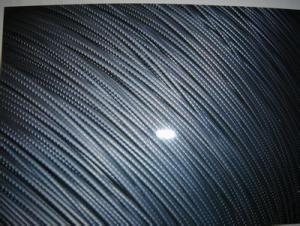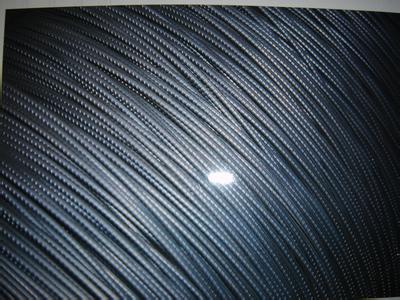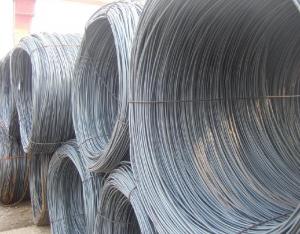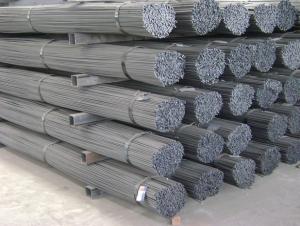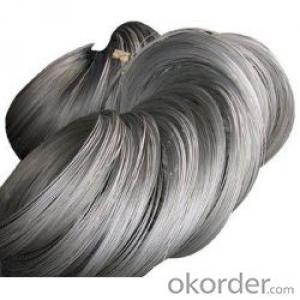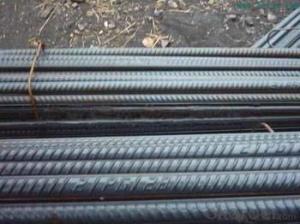Five Point Five mm Cold Rolled Steel Rebars in coils
- Loading Port:
- China Main Port
- Payment Terms:
- TT OR LC
- Min Order Qty:
- -
- Supply Capability:
- -
OKorder Service Pledge
OKorder Financial Service
You Might Also Like
Specifications of Steel Rebar:
Name | Cold Rolled Steel Rebar | | |
Diameter | 5mm, 5.5mm, 6mm, 6.5mm, 7mm, 8mm, 9mm, 10mm, 11mm, 12mm, | | |
| | |||
Length | 6M, 9M, 12M or as required | | |
Price | Keep lower operating costs so as to offer competitive price for our clients | | |
Label | to be specified by customer, generally, each bundle has1-2 labels | | |
Application | Building, construction | | |
Invoicing | Actual or Theoretical Weight Basis as buyer’s request. | ||
Theoretical weight and section area of each diameter as below for your information:
Diameter(mm) | Section area (mm²) | Mass(kg/m) | ||
5.5 | 23.7 | 0.186 | ||
Packaging & Delivery of Steel Rebar:
Packaging Detail: products are packed in bundle and then shipped by container or bulk vessel, deformed bar is usually naked strapping delivery, when storing, please pay attention to moisture proof. The performance of rust will produce adverse effect.
Each bundle weight: 2-3MT, or as required
Payment terms: TT payment in advance or Irrevocable LC at sight.
Trade terms :FOB, CFR, CIF
Delivery Detail: within 45 days after received advanced payment or LC.
- Q: Can steel rebars be used in parking garage construction?
- Indeed, steel rebars find their application in the construction of parking garages. Reinforced concrete structures, such as parking garages, frequently employ steel rebars to augment their robustness and resilience. By distributing the load and bolstering the structural integrity of the concrete, rebars enable it to withstand substantial weights typically encountered in parking garages. The incorporation of steel rebars into parking garage construction is indispensable to ensure the enduring longevity and safety of the edifice.
- Q: How do steel rebars affect the flexural strength of reinforced concrete elements?
- Steel rebars have a significant impact on the flexural strength of reinforced concrete elements. The presence of rebars in concrete elements enhances their ability to resist bending or flexural forces. Rebars, which are made of high-strength steel, are embedded within the concrete to provide tensile strength. Concrete is a strong material in compression but weak in tension. By incorporating rebars, the resulting composite material benefits from the high compressive strength of concrete and the excellent tensile strength of steel. When a flexural load is applied to a reinforced concrete element, such as a beam or a slab, the rebars distribute the load across the section, effectively resisting the tendency of the concrete to crack and fail under tension. The rebars act as reinforcements, resisting the tensile forces that arise due to bending, thereby increasing the flexural strength of the structure. The size, spacing, and arrangement of the rebars play a crucial role in determining the flexural strength of reinforced concrete elements. The proper design and placement of rebars ensure that they are optimally positioned to resist the anticipated bending forces. This requires careful consideration of factors such as the span of the element, the anticipated loads, and the desired level of strength. Furthermore, the bonding between the rebars and the concrete is essential for transferring bending stresses. Adequate concrete cover over the rebars protects them from corrosion, ensuring their durability and maintaining the integrity of the structure. Corrosion of steel rebars can weaken their bond with the surrounding concrete, compromising the flexural strength of the reinforced element. In summary, steel rebars significantly enhance the flexural strength of reinforced concrete elements by providing the necessary tensile strength to resist bending forces. Proper design, placement, and bonding of rebars are crucial to ensuring the structural integrity and durability of reinforced concrete structures.
- Q: What is the effect of welding defects on the performance of steel rebars?
- The performance of steel rebars can be significantly affected by welding defects, which can weaken their structural integrity and compromise the overall strength and durability of the construction project. Porosity is one of the common welding defects, caused by the presence of gas pockets or voids in the weld. This weakens the weld joint, reducing its load-bearing capacity and making it more prone to cracking or breaking under stress. As a result, the rebars may not be able to resist external forces, such as the weight of the structure or seismic activities, potentially leading to collapse or structural failure. Another welding defect is lack of fusion, which happens when there is insufficient bonding between the base metal and the weld metal. This creates a weak joint that can easily separate or crack under load. Lack of fusion can decrease mechanical strength and compromise structural performance as the rebars may not be able to withstand the expected load or forces. Additionally, the presence of weld spatter or excessive weld reinforcement can also have a negative impact on the performance of steel rebars. Weld spatter refers to undesirable splashes or droplets of molten metal that can stick to the rebar's surface, creating potential weak points. Excessive weld reinforcement adds unnecessary weight to the rebar and creates stress concentrations, further increasing the risk of failure. In conclusion, welding defects can significantly affect the performance of steel rebars by weakening their structural integrity, reducing load-bearing capacity, and increasing the likelihood of cracking or breaking under stress. Therefore, it is crucial to implement proper welding techniques and quality control measures to minimize or eliminate these defects and ensure the safety and reliability of the construction project.
- Q: Can steel rebars be used in structures with limited construction regulations?
- Yes, steel rebars can be used in structures with limited construction regulations. Steel rebars are commonly used in construction due to their high tensile strength and durability. However, it is important to note that even in structures with limited regulations, it is crucial to follow basic safety guidelines and ensure proper engineering and construction practices to ensure the structural integrity and safety of the building.
- Q: What are the precautions to be taken while welding steel rebars?
- To ensure safe and effective welding of steel rebars, there are several precautions that should be taken: 1. It is important to work in a well-ventilated area or use exhaust systems to remove harmful fumes and gases generated during welding. This helps maintain a safe breathing environment. 2. Welders should always wear appropriate personal protective equipment (PPE) such as a welding helmet or face shield, safety glasses, welding gloves, flame-resistant clothing, and steel-toed boots. This protective gear minimizes the risk of burns, eye injuries, and other physical hazards. 3. Fire prevention is crucial. Before starting the welding process, ensure that the work area is free of flammable materials and have a fire extinguisher nearby. It is also advisable to have a fire watch person present to monitor for potential fire hazards. 4. Proper grounding is essential to prevent electrical shocks. Ensure that the welding machine is correctly grounded and the workpiece is connected to a reliable grounding point. 5. Clean the surface of the rebars before welding. Remove any oils, grease, dirt, or rust using a wire brush or grinder, as these contaminants can affect the weld's quality. 6. Employing the correct welding technique is crucial for strong and reliable welds. Follow recommended welding parameters, such as current, voltage, and electrode diameter, and maintain a steady hand and consistent travel speed to prevent weld defects. 7. It is important to have proper training and experience when working with steel rebars. Ensure the welder is skilled and knowledgeable in this area to minimize errors and meet required standards and specifications. By adhering to these precautions, welders can significantly reduce the risk of accidents, injuries, and subpar weld quality when working with steel rebars.
- Q: What are the advantages of using high-strength steel rebars?
- Using high-strength steel rebars in construction projects brings forth several advantages. Firstly, compared to regular steel rebars, high-strength steel rebars exhibit a significantly higher yield strength. As a result, they can endure much greater tensile forces without deformation or breakage. This allows for the construction of resilient structures capable of handling heavy loads and forces, thus enhancing their durability and resistance to damage. Secondly, high-strength steel rebars possess a smaller diameter while still maintaining their strength, unlike regular steel rebars. This characteristic makes them suitable for use in limited-space areas or scenarios requiring a smaller concrete cover. Consequently, they prove particularly beneficial in projects with intricate designs or in regions prone to high seismic activity. Furthermore, high-strength steel rebars offer increased cost-efficiency. Due to their superior strength, fewer rebars are necessary in construction projects. As a result, material and labor costs are reduced. Additionally, the smaller diameter of high-strength steel rebars leads to a decreased requirement for concrete, further lowering expenses. Another advantage of high-strength steel rebars lies in their enhanced corrosion resistance. The increased strength of these rebars is often achieved by incorporating alloying elements such as chromium or nickel, which enhance their resistance to corrosion. Consequently, structures reinforced with high-strength steel rebars boast a longer lifespan and necessitate less maintenance over time. Lastly, the utilization of high-strength steel rebars facilitates the construction of lighter and more slender structures. Their superior strength-to-weight ratio permits the design of longer spans and taller buildings without compromising safety or structural integrity. Consequently, aesthetically pleasing structures are created, and architects and engineers enjoy greater flexibility in their designs. In conclusion, the advantages of employing high-strength steel rebars encompass increased strength, smaller diameter, cost-efficiency, enhanced corrosion resistance, and the ability to construct lighter and more slender structures. These benefits establish high-strength steel rebars as the preferred choice in various construction projects, ensuring durability, safety, and longevity.
- Q: What are the common grades of steel rebars?
- The common grades of steel rebars include Grade 40, Grade 60, and Grade 75.
- Q: Can steel rebars be used in aggressive chemical environments?
- To some extent, aggressive chemical environments can tolerate the use of steel rebars. However, the severity and characteristics of the chemicals present may compromise their performance. In most construction applications, steel rebars are generally resistant to mild to moderate chemical exposures. Nonetheless, in highly aggressive chemical environments with prolonged and intense exposure to corrosive substances like acids, alkalis, or salts, steel rebars may corrode and deteriorate over time. In such instances, alternative materials such as stainless steel rebars or epoxy-coated rebars may be more suitable, as they offer enhanced resistance to corrosion in aggressive chemical environments. It is crucial to consider the specific conditions of the chemical environment and seek guidance from experts or structural engineers to determine the most appropriate rebar material for the given situation. Regular inspections and maintenance are also necessary to monitor the condition of steel rebars and ensure their durability in aggressive chemical environments.
- Q: What is the role of steel rebars in load-bearing walls?
- The role of steel rebars in load-bearing walls is to provide reinforcement and strength to the structure. These rebars are embedded within the concrete to enhance its tensile strength and prevent cracking or collapsing under heavy loads. By distributing the load evenly throughout the wall, steel rebars help ensure the wall's stability and durability, making it capable of supporting the structure's weight and resisting external forces.
- Q: Like a steel rebar and wire spiral, is the same? What's the difference?
- Generally, most of the diameter of thread steel in 10-34mm, while the general disk diameter less than 10mm, but also because of too small so often set up the price must be placed, what will be a little expensive disk. A house built of steel plate with the words to be used for different purposes. The price of concrete is not clear.
Send your message to us
Five Point Five mm Cold Rolled Steel Rebars in coils
- Loading Port:
- China Main Port
- Payment Terms:
- TT OR LC
- Min Order Qty:
- -
- Supply Capability:
- -
OKorder Service Pledge
OKorder Financial Service
Similar products
Hot products
Hot Searches
Related keywords
